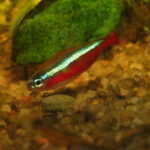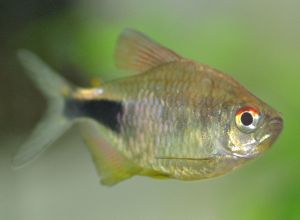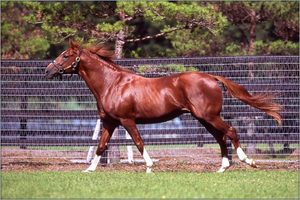Tetras run the gamut in terms of size, color, temperament and popularity. For the vast majority, these freshwater tropical fish are ideal candidates for a community aquarium set-up. One of the most famous of the tropical fish species and popular still, is the Neon Tetra(paracheirodon innesi). The Neon Tetra hails from the northern part of South America spanning from the western part of Brazil, southeaster Columbia and eastern Peru. The headwaters of the Amazon River basin are where the Neon Tetra can be seen in its greatest numbers.
Neon Tetras consist of a vivid red, silver, olive green and blue body color with a transparent fin and tail presentation. The blue and red colors do not extend all the way from the head to the tail, rather, the blue starts just behind the eye and ends at the adipose fin on the top half of the body. The red color continues where the blue color left off, but covers the bottom half of the tetras body ending at the caudal fin. They remain very small often attaining an inch and a half is all. Because of this, care must be addressed when introducing these fish to existing tank mates or future additions that are larger and more aggressive than that of the docile and smaller neon tetra. A spindle shaped body and blunt nose is associated with these tetras, as some have a more rounded body style like the Black Phantom(hyphessobrycon megalopterus) and Bleeding Heart( hyphessobrycon erythrostigma) Tetras.
It is best to house the Neon Tetra in a school or 5 or more as this is a schooling fish which feels more comfortable with other members of its kind. Moreover, the visual display associated with seeing a school of these beautiful fish is extraordinary to say the least.
The Neon Tetra is closely related to another popular tropical fish, the Cardinal Tetra(paracheirodon axelrodi) which looks almost identical to the Neon, with the undeniable exception that the red and blue coloration extend over the whole body of the Cardinal, blue on top and red on the bottom. The Green(paracheirodon simulans) and the Black(hyphessobrycon herbertaxelrodi) Tetras.
For the most part, Neon Tetras are still wild caught, though some breeding has been done in Japan and Sumatra. Breeding Neon Tetras in captivity is a very difficult achievement to perform because of the specific water conditions that must be met.
The ease of purchasing and maintaining this species of fish combined with the fact that these fish are very affordable makes them a “no brainer” when it comes to selecting hardy, colorful fish for beginners as well as for the experienced aquarist.
Tetras are fairly disease resistant with the exception that they do contact a sporozoan known as pleistophora and is known as Neon Tetra disease. Their is another type of illness known as False Neon Tetra disease and the only difference being that the false disease is caused by a bacteria, NOT a sporozoan. The symptoms are very similar and the unfortunate, all too often result is death. Their is no prevention to this parasite and often what happens is the fish will develop lumps on its body as well as a curvature of its spine. Eventually infections and death will ensue, so it is best to refrain from adding live food, such as brine shrimp to your tank unless you cultivate it yourself at home. The other way the parasite can enter your tank water is through the purchase of fish. careful inspection of each fish you plan on purchasing is crucial as well as the condition of the other specimens in the tank.
Neon Tetras require soft and slightly acidic water, a temperature around 68-80 and a pH in the neighborhood of 5.0-7.0. They will readily accept most food stuff that is small enough to consume. Tetras are omnivores, so they will fed on plant matter, crustaceans and worms and small insects. Mosquito larvae, daphnia, blood worms, baby brine shrimp, flake and frozen foods and spirulina will suffice.
It will help you to create a close representation to that that the Neon Tetras are accustomed to in the wild. Low light, dark substrate and moderately planted tank, with plenty of hiding places as well as areas to swim.
This is truly a beautiful fish that makes a great community fish addition, especially as i mentioned above as a schooling fish. You won’t have to break the bank to buy these fish and the enjoyment will be there for a long time to come since this species of Tetra, under the right conditions, can live for 10 years or so.





